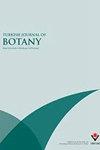Dynamics of CO2 consumption, and biomass and lipid carbon production during photobioreactor cultivation of the diatom Cyclotella
IF 1.5
4区 生物学
Q3 PLANT SCIENCES
引用次数: 0
Abstract
: Understanding of CO 2 delivery and consumption dynamics in algal photobioreactors are critical to unravel microalgae’s full potential for bioproduct generation and carbon capture from flue gas streams. This study aims to expand our current understanding by cultivating the diatom Cyclotella under controlled process conditions of a bubble column photobioreactor and analyzing CO 2 consumption dynamics in real time using results from an online CO 2 sensor connected to the reactor exhaust. Two sets of experiments were conducted: they served to contrast the influence of silicon and nitrate (Si&N colimitation) and Si limitation, and the light availability, respectively. CO 2 consumption was calculated based on the mass balance around the reactor inlet and outlet gas streams. Biomass samples and lipid extracts were analyzed for carbon (C) content to determine biomass-C and lipid-C concentrations. The outlet CO 2 concentrations varied significantly with cultivation time and process conditions. More than 15% to 65% of the CO 2 introduced left the reactor in the exhaust at any instance based on the set CO 2 transfer rates. The highest average daily capturing efficiency was 60%. Nutrient limitation regimes imposed generated unique CO 2 consumption profiles undiscernible by the biomass-C analysis, i.e. unlike Si limitation, N limitation had more immediate detrimental effects on C consumption. Final biomass-C concentration increased with increasing N and light availability, 275 mg/L vs. 336 mg/L, and 270 mg/L vs. 501 mg/L, respectively. Biomass-C based capturing efficiency approximations resulted in 20% to 40% underestimation. Under Si-limited conditions, the higher light intensity increased the final lipid-C to biomass-C ratio by two times (from 20% to 40%) and the final lipid-C concentration and peak productivity by four times (from 56 mg/L to 216 mg/L, from 7 to 30 mg/L-day, respectively). This study demonstrates online exhaust CO 2 concentration-based analysis’s unique capabilities for assessing carbon availability and capture, organic-C production, and its diversion to biomass and lipid production光生物反应器培养硅藻藻的CO2消耗动态、生物量和脂质碳产量
了解藻类光生物反应器中CO 2的输送和消耗动态对于揭示微藻在生物产品生成和烟道气流中碳捕获方面的全部潜力至关重要。本研究旨在通过在气泡柱式光生物反应器的可控工艺条件下培养硅藻Cyclotella,并利用连接到反应器排气的在线CO 2传感器的结果实时分析CO 2消耗动态,从而扩大我们目前的认识。进行了两组实验:分别用于对比硅和硝酸盐(Si&N共仿)和硅限制和光可用性的影响。根据反应器进出口气流的质量平衡计算co2消耗。分析生物质样品和脂质提取物的碳(C)含量,以确定生物量-C和脂质-C浓度。出口co2浓度随培养时间和工艺条件变化显著。根据设定的二氧化碳传输速率,在任何情况下,超过15%至65%的二氧化碳以废气的形式排出反应堆。最高平均日捕获效率为60%。施加的养分限制制度产生了独特的CO 2消耗曲线,无法被生物量-C分析所识别,即与Si限制不同,N限制对C消耗有更直接的有害影响。最终生物量c浓度随氮和光利用率的增加而增加,分别为275 mg/L和336 mg/L, 270 mg/L和501 mg/L。基于生物量- c的捕获效率近似值导致20%到40%的低估。在硅限制条件下,较高的光强使最终的脂质- c与生物量- c之比提高了2倍(从20%提高到40%),最终的脂质- c浓度和峰值产量分别提高了4倍(从56 mg/L提高到216 mg/L,从7 mg/L提高到30 mg/L-d)。这项研究展示了基于废气二氧化碳浓度的在线分析在评估碳可用性和捕获、有机碳生产及其向生物质和脂质生产的转移方面的独特能力
本文章由计算机程序翻译,如有差异,请以英文原文为准。
求助全文
约1分钟内获得全文
求助全文
来源期刊

Turkish Journal of Botany
PLANT SCIENCES-
CiteScore
2.90
自引率
5.60%
发文量
31
审稿时长
6-12 weeks
期刊介绍:
The Turkish Journal of Botany is published electronically 6 times a year by the Scientific and Technological Research Council of Turkey (TÜBİTAK) and accepts manuscripts (in English) covering all areas of plant biology (including genetics, evolution, systematics, structure, function, development, diversity, conservation biology, biogeography, paleobotany, ontogeny, functional morphology, ecology, reproductive biology, and pollination biology), all levels of organisation (molecular to ecosystem), and all plant groups and allied organisms (algae, fungi, and lichens). Authors are required to frame their research questions and discuss their results in terms of major questions in plant biology. In general, papers that are too narrowly focused, purely descriptive, or broad surveys, or that contain only preliminary data or natural history, will not be considered (*).
The following types of article will be considered:
1. Research articles: Original research in various fields of botany will be evaluated as research articles.
2. Research notes: These include articles such as preliminary notes on a study or manuscripts on the morphological, anatomical, cytological, physiological, biochemical, and other properties of plant, algae, lichen and fungi species.
3. Reviews: Reviews of recent developments, improvements, discoveries, and ideas in various fields of botany.
4. Letters to the editor: These include opinions, comments relating to the publishing policy of the Turkish Journal of Botany, news, and suggestions. Letters should not exceed one journal page.
(*) 1. Raw floristic lists (of algae, lichens, fungi, or plants), species descriptions, chorological studies, and plant sociology studies without any additional independent approaches.
2. Comparative morphology and anatomy studies (that do not cover a family, tribe, subtribe, genus, subgenus, section, subsection, or species complexes with taxonomical problems) without one or more independent additional approaches such as phylogenetical, micromorphological, chromosomal and anatomical analyses.
3. Revisions of family, tribe, genus, subgenus, section, subsection, or species complexes without any original outputs such as taxonomical status changes, IUCN categories, and phenological and ecological analyses.
4. New taxa of all plants without any additional independent approaches such as phylogenetical, ecological, chromosomal, chorological and correlational analyses in addition to a detailed macro- and micro-morphological descriptions with quality field and microscopic illustrations of taxonomically important structures and identification key in the taxonomic group.
New records of all plants without any additional independent approaches such as phylogenetical, ecological, chromosomal, chorological and correlational analyses in addition to a detailed macro- and micro-morphological descriptions with quality field and microscopic illustrations of taxonomically important structures and identification key in the taxonomic group may be accepted for peer review if they contain 3 or more new records or taxonomical status update, such as lectotypification, new combinations, transfers, revivals and synonyms.
5. New taxa of algae, lichens, and fungi without any additional independent approaches such as phylogenetical, ecological, chromosomal, chorological and correlational analyses in addition to a detailed macro- and micro-morphological descriptions with quality field and microscopic illustrations of taxonomically important structures and identification key in the taxonomic group.
New records of algae, lichens, and fungi without any additional independent approaches such as phylogenetical, ecological, chromosomal, chorological and correlational analyses in addition to a detailed macro- and micro-morphological descriptions with quality field and microscopic illustrations of taxonomically important structures and identification key in the taxonomic group may be accepted for peer review if they contain 5 or more new records or taxonomical status update, such as lectotypification, new combinations, transfers, revivals and synonyms.
 求助内容:
求助内容: 应助结果提醒方式:
应助结果提醒方式:


